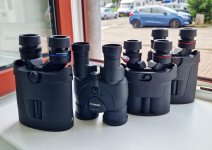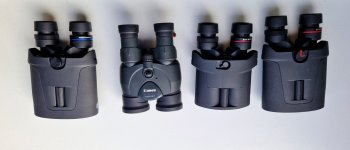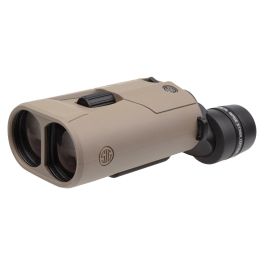As I've written in another thread about the repair of my Canon IS III 12x36, I’ve briefly tried some Kite APC stabilized binoculars at De Kijkerspecialist in the Netherlands. The test was just a few minutes looking from a window, reading a resolution test (a series of text in diminishing sizes) and the landscape in general, so I can’t seriously comment on the performance on the field, durability, etc., but here are some considerations after playing with three different Kite and comparing them to my Canon, I hope you find them useful, as well as the pictures with the compared sizes.

Kite 12x42, Canon 12x36, Kite 12x30 and Kite 16x42.
The Canon 12x36 IS III have been my main binoculars over the last two years. I hated it at the beginning and now I live with its many drawbacks, but with the amazing level of detail it provides (acceptable size/weight, great IS, nice FOV, very nice battery life, no waterproofing whatsoever, no shockproof as has been demonstrated). Some time ago I was eagerly looking forward to try the new IS line of Canon, to see if they have addressed some of the things I seriously dislike about my IS III, namely:
The need to constantly press the button if I want the IS to work: YES, they've sorted that out.
Waterproofing: NO.
Weight/size: NO, the new ones are heavier!
Close focus: YES.
So, going from 800 to 1200+ € has not make Canon give us waterproofing, the new IS is heavier and bulkier in 12x32 (compared to the old 12x36), but at least they've improved the close focus and you don't have to press the button all the time anymore. I personally find it disappointing and have close to zero interest in going from my 12x36 to the new 12x32 (and even less after reading what Roger Vine has to say about them).
Now enter the Kite stabilized line, more especifically the 12x30.
Waterproofing: YES, IPX7, nitrogen purged.
Auto power off and auto shut off if not in use.
Lighter than the Canon IS 12x32 (by a huge margin)
Cheaper, by a relevant margin.
Longer battery life.
Better warranty?
All wrapped in a robust rubber armoured body, twist-up eyecups and a compact design, promising a 3º stabilization compared to 1º in the Canon.
A short summary of some key features.
Model: Canon IS III 12x36 / Canon IS 12x32 / Kite 12x30
Weight (g): 660 / 780 / 620
Close Focus: 6 / 2 / 2,6
FOV: 5 / 5 / 5,2
Waterproof: NO / NO / YES
Battery life: 9 / 10 / 30 (plus included backup battery)
Price (€): 800 / 1200+ / 1000
It seems that Kite took good note of the weaknesses of the Canon line and one by one improved on every major area.
And what about the view?
As I wrote at the beginning, I can't do any serious review of the performance (let alone durability), but here are some findings comparing the he Canon IS III 12x36 and the Kite 12x30 (yes, the IS III is a bit dated, and I should have compared the Kite to the newest Canon IS 12x32, but I don't own one).
Resolution: I could read a similar level of detail with both.
Build: this is something that has always worried me about my 12x36 ISIII. The Canon feels like a cheap toy made of plastic with a terrible "hollow" sound; the Kite has some rubber armouring and when you hold it the feeling is that of a properly built device: nothing rattles, it feels robust and reassuring. In addition to this, you can get a dedicated rubber "skin" (not unlike a rubber case for a smartphone) that should improve the level of protection to some extent.
Operation: the Kite is a breeze. What a change. The focus wheel on the Kite is a bit awkward at the beginning, compared to the more conventional focus wheel position and operation on the Canon. Obviously this is the kind of thing where you need time to see if you get used to it.
Image quality. Bear in mind that I had a brief encounter with the Kite, but enough to be really impressed. Given the small dimensions and price (compared to the current Canon IS) I expected the optical performance to be on a lower level, but the basic parameters of brightness and contrast were similar. As a matter of fact, I found the Kite to be sharper and display a more constrasty image than the Canon (this was quite a surprise). It somehow reminded me of the Canon IS 8x20, which I find offers a more contrasty image compare to the 12x36 ISIII
CA: not enough time with the Kite, but what I could see was not worse than the Canon (well, how could it be!!
 ).
).
Field of view was very similar, pleasing in both cases. One thing I could not compare was the sweet spot size, which is one of the biggest strengths of the Canon, especially noticeable when stargazing. I doubt the Kite can approach the stellar performance, but I simply didn't have the chance to compare that particular feature. However, I didn't feel the sweet spot on the Kite was lacking.
In short: a more compact body (nearly 1 cm shorter), a way (but way) better feel on the hand, similar (not worse, better in some cases) performance in some key optical areas and the peace of mind of waterproofnes and the renowned warranty of the Belgian brand. Had my Canon not been repaired, I'm confident I would have walked out of the shop with a 12x30 Kite. I would advise anyone considering an IS to check it out before deciding on a model.
And why the 12x30? It seems 12 times for a 30 mm objective is a bit on the tight side. Well, "yes, but". Let's see (same suspects as on the previous picture).

Kite 12x42, Canon 12x36, Kite 12x30 and Kite 16x42.
I was able to also try the 12x42 and 16x42, but here's the thing.
The 12x42 is surprisingly light (lighter than a 12x32 Canon), but there's a dealbreaker: FOV. It has been mentioned here on BF before, but there's a puzzling issue with the new APC lines of Kite, both in 42 and 30 mm. There are two models for each objective size, 10x/12x30 and 12x/16x42, and in both cases it's the higher mag that enjoys the better FOV. I don't know if it has to do with some decisions during the production (in order to save costs) but here it is, the sad a raw figures:
10x30: 5,5º
12x30: 5,2º
12x42: 3,85º
16x42: 3,9º
Yes, you read it right, the 16x has a wider FOV than its 12 sibling, which is puzzling and disappointing to say the least. The 10x30 is not that bad at 5,5º (although 6º like a Canon would have been better obviously), but 5,2º for a 12x seems to be more satisfying.
So, after trying the 12x30, the 12x42 simply feels claustrophobic. Maybe if you didn't try anything else, you could use it, but 3,85º for a 12x is really noticeable if you're used to 5º-ish devices.
When it comes to detail, I could resolve more or less the same level of detail with both the 12x30 and 12x42 (and my 12x36 Canon). Obviously the 12x42 should outperform the 12x30 on gloomy days and low light.
And then there's the 16x42, which I think of as an speciality glass. Yes, you could resolve things with the 16x that you simply can't with a 12x, but I found the level of CA worrying (and mind you, I'm coming from a 12x36 Canon, a model with CA to spare). So, while I haven't tried the 10x30, which sounds like an interesting proposition (I imagine CA at a lower level), I found 12x30 was a stunning little IS with remarkable performance. I prefer it basically on almost every aspect to my Canon (sweet spot size remains to be confirmed).
I hope this little gaze into the line of Kite can give you some clues and interesting insights.

Kite 12x42, Canon 12x36, Kite 12x30 and Kite 16x42.
The Canon 12x36 IS III have been my main binoculars over the last two years. I hated it at the beginning and now I live with its many drawbacks, but with the amazing level of detail it provides (acceptable size/weight, great IS, nice FOV, very nice battery life, no waterproofing whatsoever, no shockproof as has been demonstrated). Some time ago I was eagerly looking forward to try the new IS line of Canon, to see if they have addressed some of the things I seriously dislike about my IS III, namely:
The need to constantly press the button if I want the IS to work: YES, they've sorted that out.
Waterproofing: NO.
Weight/size: NO, the new ones are heavier!
Close focus: YES.
So, going from 800 to 1200+ € has not make Canon give us waterproofing, the new IS is heavier and bulkier in 12x32 (compared to the old 12x36), but at least they've improved the close focus and you don't have to press the button all the time anymore. I personally find it disappointing and have close to zero interest in going from my 12x36 to the new 12x32 (and even less after reading what Roger Vine has to say about them).
Now enter the Kite stabilized line, more especifically the 12x30.
Waterproofing: YES, IPX7, nitrogen purged.
Auto power off and auto shut off if not in use.
Lighter than the Canon IS 12x32 (by a huge margin)
Cheaper, by a relevant margin.
Longer battery life.
Better warranty?
All wrapped in a robust rubber armoured body, twist-up eyecups and a compact design, promising a 3º stabilization compared to 1º in the Canon.
A short summary of some key features.
Model: Canon IS III 12x36 / Canon IS 12x32 / Kite 12x30
Weight (g): 660 / 780 / 620
Close Focus: 6 / 2 / 2,6
FOV: 5 / 5 / 5,2
Waterproof: NO / NO / YES
Battery life: 9 / 10 / 30 (plus included backup battery)
Price (€): 800 / 1200+ / 1000
It seems that Kite took good note of the weaknesses of the Canon line and one by one improved on every major area.
And what about the view?
As I wrote at the beginning, I can't do any serious review of the performance (let alone durability), but here are some findings comparing the he Canon IS III 12x36 and the Kite 12x30 (yes, the IS III is a bit dated, and I should have compared the Kite to the newest Canon IS 12x32, but I don't own one).
Resolution: I could read a similar level of detail with both.
Build: this is something that has always worried me about my 12x36 ISIII. The Canon feels like a cheap toy made of plastic with a terrible "hollow" sound; the Kite has some rubber armouring and when you hold it the feeling is that of a properly built device: nothing rattles, it feels robust and reassuring. In addition to this, you can get a dedicated rubber "skin" (not unlike a rubber case for a smartphone) that should improve the level of protection to some extent.
Operation: the Kite is a breeze. What a change. The focus wheel on the Kite is a bit awkward at the beginning, compared to the more conventional focus wheel position and operation on the Canon. Obviously this is the kind of thing where you need time to see if you get used to it.
Image quality. Bear in mind that I had a brief encounter with the Kite, but enough to be really impressed. Given the small dimensions and price (compared to the current Canon IS) I expected the optical performance to be on a lower level, but the basic parameters of brightness and contrast were similar. As a matter of fact, I found the Kite to be sharper and display a more constrasty image than the Canon (this was quite a surprise). It somehow reminded me of the Canon IS 8x20, which I find offers a more contrasty image compare to the 12x36 ISIII
CA: not enough time with the Kite, but what I could see was not worse than the Canon (well, how could it be!!
Field of view was very similar, pleasing in both cases. One thing I could not compare was the sweet spot size, which is one of the biggest strengths of the Canon, especially noticeable when stargazing. I doubt the Kite can approach the stellar performance, but I simply didn't have the chance to compare that particular feature. However, I didn't feel the sweet spot on the Kite was lacking.
In short: a more compact body (nearly 1 cm shorter), a way (but way) better feel on the hand, similar (not worse, better in some cases) performance in some key optical areas and the peace of mind of waterproofnes and the renowned warranty of the Belgian brand. Had my Canon not been repaired, I'm confident I would have walked out of the shop with a 12x30 Kite. I would advise anyone considering an IS to check it out before deciding on a model.
And why the 12x30? It seems 12 times for a 30 mm objective is a bit on the tight side. Well, "yes, but". Let's see (same suspects as on the previous picture).

Kite 12x42, Canon 12x36, Kite 12x30 and Kite 16x42.
I was able to also try the 12x42 and 16x42, but here's the thing.
The 12x42 is surprisingly light (lighter than a 12x32 Canon), but there's a dealbreaker: FOV. It has been mentioned here on BF before, but there's a puzzling issue with the new APC lines of Kite, both in 42 and 30 mm. There are two models for each objective size, 10x/12x30 and 12x/16x42, and in both cases it's the higher mag that enjoys the better FOV. I don't know if it has to do with some decisions during the production (in order to save costs) but here it is, the sad a raw figures:
10x30: 5,5º
12x30: 5,2º
12x42: 3,85º
16x42: 3,9º
Yes, you read it right, the 16x has a wider FOV than its 12 sibling, which is puzzling and disappointing to say the least. The 10x30 is not that bad at 5,5º (although 6º like a Canon would have been better obviously), but 5,2º for a 12x seems to be more satisfying.
So, after trying the 12x30, the 12x42 simply feels claustrophobic. Maybe if you didn't try anything else, you could use it, but 3,85º for a 12x is really noticeable if you're used to 5º-ish devices.
When it comes to detail, I could resolve more or less the same level of detail with both the 12x30 and 12x42 (and my 12x36 Canon). Obviously the 12x42 should outperform the 12x30 on gloomy days and low light.
And then there's the 16x42, which I think of as an speciality glass. Yes, you could resolve things with the 16x that you simply can't with a 12x, but I found the level of CA worrying (and mind you, I'm coming from a 12x36 Canon, a model with CA to spare). So, while I haven't tried the 10x30, which sounds like an interesting proposition (I imagine CA at a lower level), I found 12x30 was a stunning little IS with remarkable performance. I prefer it basically on almost every aspect to my Canon (sweet spot size remains to be confirmed).
I hope this little gaze into the line of Kite can give you some clues and interesting insights.







